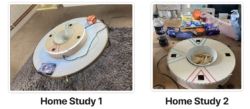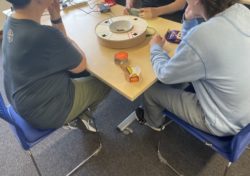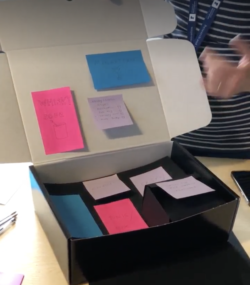01
04
.25
Unpacking the Recurrent Value of Digitally Augmented FMCGs – final blog
We’ve now come to the end of our project ‘Unpacking the Recurrent Value of Digitally Augmented FMCGs’, and we’ve been reflecting on what we achieved over the last 18 months in amongst navigating work that sometimes sat outside the comfort zone of our research ethics committee, and tried to engage with industry at both extremes of the size spectrum.

Figure 1 The snack-bowl in a home study
We’re most proud of the hybrid snacking-bowl technology probe that we described in our last blog post. The sharing technology probe embedded simple game mechanics to track turn-taking while snacking in a group social setting. We built upon the role played by bowls in group snacking contexts, for example bowls are filled and replenished with snacks – crisps, nuts etc, – decanted from their original packaging and so ripe for digital augmentation. Bowls are shared by the group and either used in place or passed around. The act of taking a snack, who has taken a snack, and how many snacks are remaining is visible to the group, in contrast to each member of the group having their own packet. Thinking about commensality, we tried to get away from the conventional conceit of apps for tracking, and instead embedded playful interactivity into the bowl for the group to share.

Figure 2 A group of players in the lab with the snack-bowl
We deployed the bowl at first in a series of lab experiments, where we invited participants in groups to play a casual card game to which the bowl was a companion. Our researcher then conducted an auto-ethnographic study that situated the bowl in a home environment, where snacks were typically consumed alongside playing board games.
So, what did we find? Engagement with the bowl was surprisingly rich and compelling. Our participants were quick to understand and, from social pressure and anticipated judgement from their group, comply with the perceived rules of the bowl’s turn taking rhythm. The bowl superseded the usual rituals of shared snacking and regulated turn-taking, but also served as an ice-breaker in a group where the participants didn’t know one another. The bowl gave our participants something to discuss and to engage with when it wasn’t their turn in the card game, and they successfully interleaved the two turn taking rhythms, albeit occasionally while missing a turn at the bowl. Our participants interacted with and referred to the bowl as a game in and of itself, although whether it was a sufficiently prominent game was a matter of some debate.
Overall, our findings revealed how the snack bowl elicited togetherness, reflection and social pressure whilst also influencing group snacking habits. We generated guidelines for augmenting everyday tangible objects for use in group settings, including their potential to enhance the value of low-cost FMCGs through temporal and ludic design elements. Our paper on the bowl is currently under review at DIS.
At the same time, we continued with our work on augmenting packaging, focusing on understanding the finer details of augmenting a drinks box with digital components. With our aim of looking past the usual surface novelty of just adding augmented reality, we found tensions between the attraction of physical components to hand and the lack of an immediate incentive or need to engage with digital elements. We found that digital components were primarily seen as an opportunity to offload information provision from physical packaging, especially when it was not immediately useful to the task at hand. We explored perceptions of the different technologies for associating digital content with the box – art codes, QR codes – but notably we also explored specifically where on the box they might to best complement rather than complicate the physical product experience.

Figure 3Participants designing a hybrid drinks box
We conducted different forms of physical and digital prototyping to explore ideas for hybrid interactions and user experiences with a digitally augmented mocktail drinks kit. This included a prototypical augmented reality scene, developed for mobile devices using Unity with the Vuforia AR middleware, which enabled users to engage with a bartender character to access drink-making instructions, and also to access digital content that encompassed all of the kits instructions that they were able to add to their persistent profile. Our aim was to consider interactions with this box kit as well as interactions across all of the kits that had been purchased. Finally, we considered a multiuser scenario where a user might host an event for friends around the drinks kit. We used a Wizard-of-Oz technique to explore how the bartender agent might facilitate a mocktail event, but integrating the user’s mobile device into the kit packaging rather than being solely handheld, in order to consider the transitions between primarily physical or digital interactions at different stages in the experience.
Sadly, we didn’t quite have time to finish off this leg of the project, but we now have a variety of prototypes of different levels of fidelity that we’re keeping on the back burner.
Tags:
artcodes,
FMCGs,
prototypes,
QR codes
















